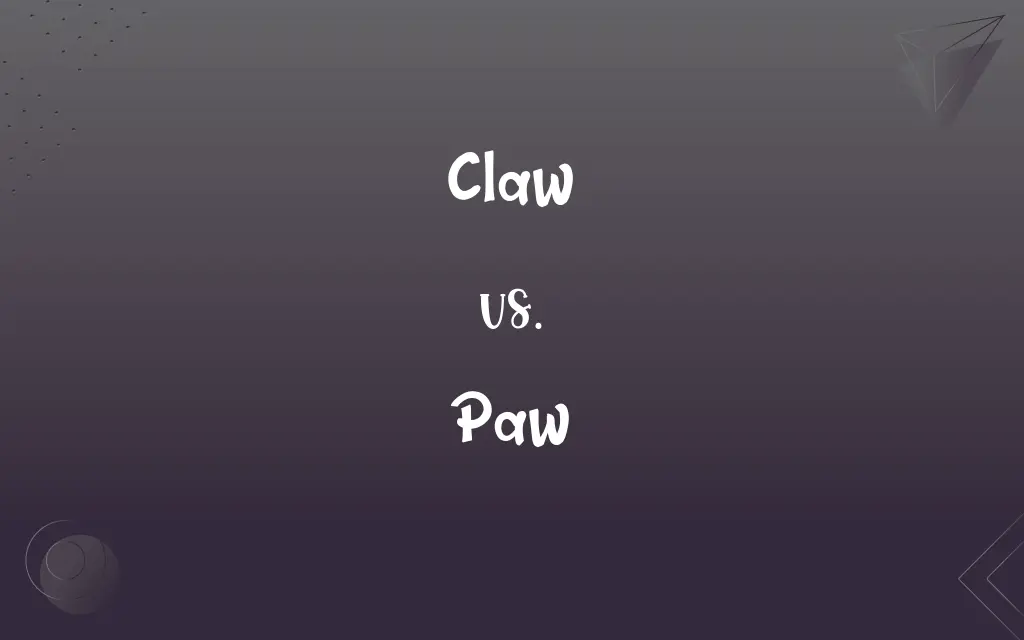Claw vs. Paw: What's the Difference?
Edited by Harlon Moss || By Janet White || Updated on July 8, 2024
Claw is a sharp, curved nail on the foot of an animal, while a paw is the soft foot of a mammal, typically with claws or nails.

Key Differences
Claw and paw are terms used to describe different components of an animal's anatomy. A claw is a pointed, typically curved, nail that grows at the end of the toes or fingers of an animal. It serves various functions, including catching prey, climbing, and defending. In contrast, a paw is the whole foot of an animal that has claws or nails, such as a cat, dog, or bear. It includes the soft, fleshy underside as well as the nails or claws and is integral to the animal's mobility.
Claws, due to their sharp and pointed nature, are often perceived as weapons in the animal kingdom. They can be used to grip, rip, and tear, offering both offensive and defensive capabilities. On the other hand, paws, serving as the base of an animal's limbs, aid in walking, running, and sensing the environment, providing support and balance and functioning as a tactile organ in some animals.
When considering the anatomical structure, a claw is the hardened and thickened development of the skin, mostly keratin, located at the end of a digit. It’s a specialized nail that can be retracted or protracted in some animals. Conversely, a paw is a more complex structure, comprising bones, joints, pads, nails or claws, and often, fur. It’s versatile, allowing animals to move gracefully and adapt to different terrains.
In contextual usage, claw generally refers to the sharp, curved nails of animals like birds of prey, reptiles, and some mammals. It’s commonly associated with hunting and climbing behaviors. Paw, however, denotes the entire foot of a mammal, especially those of quadrupeds, and is associated with characteristics like softness, padding, and often, cuteness.
In essence, claw refers to a sharp, typically curved, and pointed nail on an animal's finger or toe, mainly serving for catching and holding prey, whereas paw is the soft foot of a mammal, generally a quadruped, which has claws or nails and is used for movement and balance.
ADVERTISEMENT
Comparison Chart
Definition
A sharp, curved, pointed nail on an animal's toe or finger
The foot of a mammal, typically having claws or nails
Function
Used for catching prey, climbing, and defending
Used for movement, balance, and sensing the environment
Structure
Hardened and thickened development of skin, mainly keratin
Comprises bones, joints, pads, nails or claws, and sometimes fur
Contextual Usage
Associated with birds of prey, reptiles, and some mammals
Generally refers to the entire foot of quadrupeds
Perception
Often perceived as a weapon
Often associated with softness and cuteness
ADVERTISEMENT
Claw and Paw Definitions
Claw
A claw is a sharp, curved, pointed nail on an animal's toe or finger.
The eagle used its claw to catch its prey.
Paw
Paw can be a person's hand, especially one that is large, rough, or clumsy.
His large paw enveloped her small hand.
Claw
Claw can be a mechanical device resembling a claw, used for gripping or lifting.
The claw machine at the arcade was full of plush toys.
Paw
Paw is used to describe the action of an animal striking or scraping with its paws.
The cat pawed at the dangling string.
Claw
Claw, in botany, is a hooked or recurved, slender shoot.
The claw of the plant wrapped around the support.
Paw
The foot of an animal, especially a quadruped, that has claws or nails.
Claw
A sharp, curved, horny structure at the end of a toe of a vertebrate animal.
Paw
(Informal) A human hand, especially a large clumsy one
"Lennie dabbled his big paw in the water" (John Steinbeck).
Claw
A chela or similar pincerlike structure on the end of a limb of a crustacean or arachnid.
Paw
To feel or strike with the paw or paws.
Claw
One of one or more small curved structures at the tip of an appendage of an invertebrate, especially an insect or other arthropod.
Paw
To strike or scrape with a beating motion
The bull pawed the ground before charging.
Claw
A limb terminating in such a structure.
Paw
To touch or handle clumsily or roughly.
Claw
Something, such as the cleft end of a hammerhead, that resembles a claw.
Paw
To feel or touch (another) in an annoying or unwanted way.
Claw
(Botany) A narrowed, stalklike basal part of a petal, sepal, or bract.
Paw
To scrape the ground with the forefeet
The horse pawed restlessly.
Claw
To scratch, dig, tear, or pull with the claws or fingernails.
Paw
To handle someone or something clumsily, rudely, or with too much familiarity
Don't paw at everything you see.
Claw
A curved, pointed horny nail on each digit of the foot of a mammal, reptile, or bird.
Paw
The soft foot of a mammal or other animal, generally a quadruped, that has claws or nails; comparable to a human hand or foot.
Claw
A foot equipped with such.
Paw
(humorous) A hand.
Get your grubby paws off my things!
Claw
The pincer (chela) of a crustacean or other arthropod.
Paw
Father; pa.
Claw
A mechanical device resembling a claw, used for gripping or lifting.
Paw
(of an animal) To go through something (such as a garbage can) with paws.
Claw
(colloquial) A human fingernail, particularly one extending well beyond the fingertip.
Paw
(of an animal) To gently push on something with a paw.
Claw
(botany) A slender appendage or process, formed like a claw, such as the base of petals of the pink.
Paw
(of an animal) To draw the forefoot along the ground; to beat or scrape with the forefoot.
Claw
(juggling) The act of catching a ball overhand.
Paw
(by extension) To touch someone in a sexual way.
Claw
To scratch or to tear at.
Paw
(by extension) To clumsily dig through something.
Claw
To use the claws to seize, to grip.
Paw
To flatter.
Claw
To use the claws to climb.
Paw
The foot of a quadruped having claws, as the lion, dog, cat, etc.
Claw
(juggling) To perform a claw catch.
Paw
The hand.
Claw
To move with one's fingertips.
Paw
To draw the forefoot along the ground; to beat or scrape with the forefoot.
Claw
To relieve an uneasy feeling, such as an itch, by scratching (someone or something); hence (figuratively), to flatter or humour (someone); to court, to fawn on.
Paw
To pass the paw over; to stroke or handle with the paws; hence, to handle fondly or rudely.
Claw
To rail at, revile, or scold (someone or something).
Paw
To scrape or beat with the forefoot.
His hot courser pawed the Hungarian plane.
Claw
To do (something) quickly.
Paw
A clawed foot of an animal especially a quadruped
Claw
A sharp, hooked nail, as of a beast or bird.
Paw
The (prehensile) extremity of the superior limb;
He had the hands of a surgeon
He extended his mitt
Claw
The whole foot of an animal armed with hooked nails; the pinchers of a lobster, crab, etc.
Paw
Scrape with the paws;
The bear pawed the door
Claw
Anything resembling the claw of an animal, as the curved and forked end of a hammer for drawing nails.
Paw
Touch clumsily;
The man tried to paw her
Claw
A slender appendage or process, formed like a claw, as the base of petals of the pink.
Paw
A paw is the soft foot of a mammal, typically with claws or nails.
The dog injured its paw while running.
Claw
To pull, tear, or scratch with, or as with, claws or nails.
Paw
Paw refers to the human hand, humorously or contemptuously.
He greedily grabbed the candy with his paw.
Claw
To relieve from some uneasy sensation, as by scratching; to tickle; hence, to flatter; to court.
Rich men they claw, soothe up, and flatter; the poor they contemn and despise.
Paw
Paw denotes the foot of an animal, especially a quadruped, with claws or nails.
The lion's paw is both strong and agile.
Claw
To rail at; to scold.
In the aforesaid preamble, the king fairly claweth the great monasteries, wherein, saith he, religion, thanks be to God, is right well kept and observed; though he claweth them soon after in another acceptation.
Claw
To scrape, scratch, or dig with a claw, or with the hand as a claw.
Claw
Sharp curved horny process on the toe of a bird or some mammals or reptiles
Claw
A mechanical device that is curved or bent to suspend or hold or pull something
Claw
A structure like a pincer on the limb of a crustacean or other arthropods
Claw
A bird's foot that has claws
Claw
Move as if by clawing, seizing, or digging;
They clawed their way to the top of the mountain
Claw
Clutch as if in panic;
She clawed the doorknob
Claw
Scratch, scrape, pull, or dig with claws or nails
Claw
Attack as if with claws;
The politician clawed his rival
Claw
Claw refers to a slender, pointed, usually curved object, resembling or suggesting the claw of an animal or bird.
The claw of a hammer is used to remove nails.
Claw
Claw denotes the pincerlike extremity of specific limbs of some arthropods.
The lobster's claw can exert impressive pressure.
FAQs
Can humans have claws?
No, humans have nails, not claws, which are flat and not curved or pointed like claws.
Is a paw exclusive to mammals?
Typically, yes; the term paw usually refers to the foot of a mammal.
Are claws only for carnivorous animals?
No, various animals, including herbivores and omnivores, have claws, like the sloth and the panda.
Are claws present in all reptiles?
While many reptiles have claws, not all do; for example, snakes do not have claws.
Can claws be retracted?
Yes, some animals, like cats, can retract their claws.
Can a claw be a tool?
Yes, claws can serve as tools for animals to catch prey, climb, or dig.
Do all paws have claws?
Most paws have claws or nails, but not always; for example, the paws of some rodents have soft nails.
Do paws sweat?
Yes, some animals, like dogs, have sweat glands in their paws.
Can claws be a means of defense?
Absolutely, many animals use their claws as a means of defense against predators.
Are paws sensitive?
Yes, many animals have sensitive paws that can detect vibrations and changes in terrain.
Can paws have different shapes?
Yes, paws can have different shapes, depending on the species and their environment.
Can claws grow back?
Yes, most claws can grow back if they are damaged or removed, but the process may vary depending on the species.
Is the paw an organ of sensation?
In many animals, the paw is indeed a tactile organ and can be very sensitive to touch.
Do all birds have claws?
Most birds have claws at the ends of their toes, used for perching, grabbing, or hunting.
Can paws be webbed?
Yes, some animals, like ducks and otters, have webbed paws to aid in swimming.
About Author
Written by
Janet WhiteJanet White has been an esteemed writer and blogger for Difference Wiki. Holding a Master's degree in Science and Medical Journalism from the prestigious Boston University, she has consistently demonstrated her expertise and passion for her field. When she's not immersed in her work, Janet relishes her time exercising, delving into a good book, and cherishing moments with friends and family.
Edited by
Harlon MossHarlon is a seasoned quality moderator and accomplished content writer for Difference Wiki. An alumnus of the prestigious University of California, he earned his degree in Computer Science. Leveraging his academic background, Harlon brings a meticulous and informed perspective to his work, ensuring content accuracy and excellence.































































